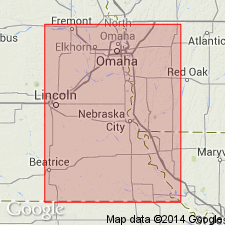
- Usage in publication:
-
- Church limestone bed
- Modifications:
-
- Original reference
- Dominant lithology:
-
- Limestone
- AAPG geologic province:
-
- Forest City basin
Summary:
Pg. 42, 54. Church limestone bed of Howard limestone member of Wabaunsee formation. Lower limestone of Howard limestone member of Wabaunsee formation. Bluish gray, dense, brittle, massive, quite fossiliferous, and in 1 or 2 beds forming large blocks. Thickness 2 to 6 feet. Underlies Kiewitz shale and overlies Severy shale member, which contains Nodaway coal 4 feet below top. Age is Pennsylvanian. Report includes cross sections, measured sections, geologic maps, stratigraphic tables.
Named from Church farm, on Turner Creek, southeast of Du Bois, NE.
Source: US geologic names lexicon (USGS Bull. 896, p. 442); GNC KS-NE Pennsylvanian Corr. Chart, sheet 1, Oct. 1936; supplemental information from GNU records (USGS DDS-6; Denver GNULEX).
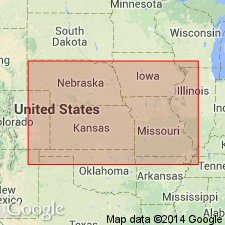
- Usage in publication:
-
- Church limestone member
- Modifications:
-
- Revised
- AAPG geologic province:
-
- Cherokee basin
Summary:
Pg. 20, 21, 94, 96; R.C. Moore and G.E. Condra, 1932 (Oct. 1932 revised classification chart of Pennsylvanian rocks of Nebraska and Kansas). Church limestone member of Howard limestone of Wabaunsee group. Defined Church limestone as underlain by Aarde shale (shown as a younger bed than Severy shale) and overlain by Winzeler shalae, and as beloging in middle of Howard limestone. Age is Late Pennsylvanian (Virgil).
Source: US geologic names lexicon (USGS Bull. 896, p. 442); GNC KS-NE Pennsylvanian Corr. Chart, sheet 2, Oct. 1936.

- Usage in publication:
-
- Church limestone member
- Modifications:
-
- Overview
Summary:
Pg. 207-208. Church limestone member of Howard limestone of Wabaunsee group. Church limestone is most persistent and important member of Howard limestone. It overlies Aarde shale, or where Bachelor Creek limestone is absent and Aarde shale is not differentiated, it forms basal unit of Howard limestone and rests on Severy shale. It underlies Winzeler shale. Thickness 1.5 to 6 feet. Age is Late Pennsylvanian (Virgil).
Type locality, Church farm, on Turner Creek, southeast of Du Bois, Nebraska.
Source: US geologic names lexicon (USGS Bull. 896, p. 442); GNC KS-NE Pennsylvanian Corr. Chart, sheet 2, Oct. 1936.
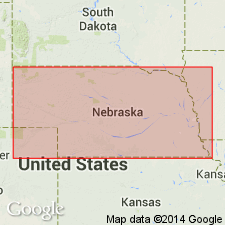
- Usage in publication:
-
- [Church limestone member]
- Modifications:
-
- Areal extent
Summary:
Pg. 19. [Church limestone member of Howard limestone.] Mentioned as occurring in Iowa and Missouri.
Source: US geologic names lexicon (USGS Bull. 1200, p. 797).
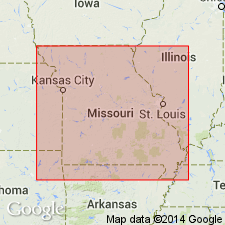
- Usage in publication:
-
- Church limestone member*
- Modifications:
-
- Overview
Summary:
Pg. 19-20. Church, Winzeler, and Utopia members of Howard limestone are readily distinguishable in Missouri as the two thin limestones with intervening shale described as units of the Howard by McQueen and Greene (1938, Missouri Geol. Survey and Water Res., 2nd ser., v. 25, pl. 5).
Source: US geologic names lexicon (USGS Bull. 1200, p. 797).
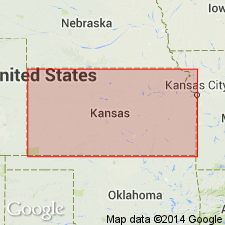
- Usage in publication:
-
- Church limestone member*
- Modifications:
-
- Overview
Summary:
Pg. 170 (fig. 34), 173-174. Most persistent and important limestone member of Howard formation. Commonly a single massive bed of dark-blue to dark-gray limestone. Thickness ranges from about 1.5 to 6 feet, the average a little more than 2 feet. Underlies Winzeler shale; overlies Aarde shale member. Where Bachelor Creek limestone is absent and Aarde shale cannot be differentiated, Church limestone is considered as forming basal unit of the Howard, resting on [/]Severy-Aarde shale.
[The use of a hyphen between undifferentiated [members] is not considered proper notation (CSN, 1933).]
Source: US geologic names lexicon (USGS Bull. 1200, p. 797).
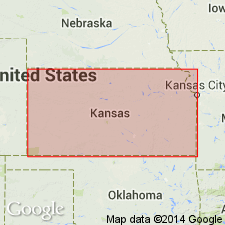
- Usage in publication:
-
- Church Limestone Member*
- Modifications:
-
- Overview
Summary:
(Paleozoic Era; Pennsylvanian System by J.M Jewett, H.G. O'Connor, and D.E. Zeller, p. 40.) Church Limestone Member of Howard Limestone of Sacfox subgroup [informal] of Wabaunsee Group. In Kansas, is commonly one massive bed of bluish-gray limestone that weathers yellowish-brown. Crinoid remains, productid brachiopods, and stromatoliths are common. A thin "zone" at the top contains abundant bryozoans, and fusulinids occur sparingly in the upper part in southeastern Kansas. Thickness 1.5 to 6 feet. Underlies Winzeler Shale Member and overlies Aarde Shale Member, both of Howard. Age is Late Pennsylvanian (Virgilian).
["Subgroup" not recognized as a formal stratigraphic rank term (CSN, 1933; ACSN, 1961, 1970; NACSN, 1983, 2005, 2021). Considered informal and should not be capitalized.]
Source: Publication.
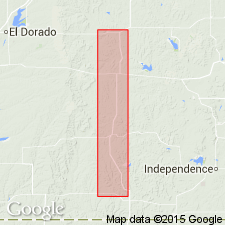
- Usage in publication:
-
- Church Limestone Member
- Modifications:
-
- Contact revised
- AAPG geologic province:
-
- Cherokee basin
Summary:
The lower contact of Church Limestone Member of Howard Limestone of Wabaunsee Group revised. Church now overlies newly named [Shanghai Creek] Shale Member. Church described as a rusty-brown, gray weathering, even-bedded (with a subconchoidal fracture), dense, fossiliferous limestone (citing Pawel, 1975). Is consistently 2 to 3.5 feet thick. Underlies Winzeler Shale Member of Howard Limestone. Occurs in southern Kansas, in the Cherokee basin. Fossils include gastropods, crinoid fragments, brachiopods, fusulinids, corals, pelecypods, bryozoans, and distinctive algae OTTONOSIA. Age is Late Pennsylvanian (Virgilian). Report includes measured sections.
Source: Modified from GNU records (USGS DDS-6; Denver GNULEX).
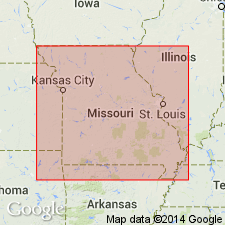
- Usage in publication:
-
- Church Limestone Member
- Modifications:
-
- Overview
Summary:
Pg. 127 (fig. 37), 128. Church Limestone Member of Howard Formation of Sacfox subgroup [informal] of Wabaunsee Group. Recognized in northwestern Missouri. A single bed of medium- to dark-bluish-gray, brittle limestone, which weathers to rusty-brown; about 18 inches thick. Fossiliferous (gastropods, brachiopods, crinoids, bryozoans). Occurs above Aarde Shale Member and below Winzeler Shale Member, both of Howard. Age is Late Pennsylvanian (Virgilian).
["Subgroup" not recognized as a formal stratigraphic rank term (CSN, 1933; ACSN, 1961, 1970; NACSN, 1983, 2005, 2021). Considered informal and should not be capitalized.]
Source: Publication.
For more information, please contact Nancy Stamm, Geologic Names Committee Secretary.
Asterisk (*) indicates published by U.S. Geological Survey authors.
"No current usage" (†) implies that a name has been abandoned or has fallen into disuse. Former usage and, if known, replacement name given in parentheses ( ).
Slash (/) indicates name conflicts with nomenclatural guidelines (CSN, 1933; ACSN, 1961, 1970; NACSN, 1983, 2005, 2021). May be explained within brackets ([ ]).

